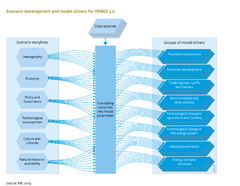Drivers: Difference between revisions
Jump to navigation
Jump to search
No edit summary |
No edit summary |
||
| Line 1: | Line 1: | ||
{{ComponentTemplate2 | {{ComponentTemplate2 | ||
|Status=On hold | |Status=On hold | ||
|Description= | |KeyReference=IPCC, 2000; OECD, 2012; Millennium Ecosystem Assessment, 2006; | ||
In order for the IMAGE model to explore future scenarios, exogenous assumptions need to be made for a range of factors that shape the direction and rate of change in key model variables and results. Together with the endogenous functional relationships and endogenous model parameters that jointly typify the behaviour of the model, these exogenous assumptions drive the outcome of any particular model calculation. In other words, these assumptions are the drivers that determine the model results subject to the assumed external conditions. | |FrameworkElementType=driver | ||
|Description=In order for the IMAGE model to explore future scenarios, exogenous assumptions need to be made for a range of factors that shape the direction and rate of change in key model variables and results. Together with the endogenous functional relationships and endogenous model parameters that jointly typify the behaviour of the model, these exogenous assumptions drive the outcome of any particular model calculation. In other words, these assumptions are the drivers that determine the model results subject to the assumed external conditions. | |||
For IMAGE, six groups of assumptions are distinguished that make up the scenario drivers. In this chapter these six scenario drivers will be described. These drivers are the basis of any scenario and are generally rooted in a scenario narrative or storyline. This includes cases where current trends and dynamics are assumed to continue into the future; commonly referred to as reference or ‘business-as-usual’ cases. As a rule, scenario drivers do not constitute numerical model inputs, but they do govern in qualitative or semi-quantitative terms the more elaborate set of exogenous assumptions in terms of model input files for the various parts of the model framework. In other words, numerical model drivers for any specific scenario will need to be established on the basis of the six more generic scenario drivers. The model drivers for the various modules will be explained in more detail in the following Chapters 4 through 8. The scenario drivers and underlying narrative, together with the concrete quantitative model drivers form a scenario, inextricably linked with the results from the IMAGE scenario run | For IMAGE, six groups of assumptions are distinguished that make up the scenario drivers. In this chapter these six scenario drivers will be described. These drivers are the basis of any scenario and are generally rooted in a scenario narrative or storyline. This includes cases where current trends and dynamics are assumed to continue into the future; commonly referred to as reference or ‘business-as-usual’ cases. As a rule, scenario drivers do not constitute numerical model inputs, but they do govern in qualitative or semi-quantitative terms the more elaborate set of exogenous assumptions in terms of model input files for the various parts of the model framework. In other words, numerical model drivers for any specific scenario will need to be established on the basis of the six more generic scenario drivers. The model drivers for the various modules will be explained in more detail in the following Chapters 4 through 8. The scenario drivers and underlying narrative, together with the concrete quantitative model drivers form a scenario, inextricably linked with the results from the IMAGE scenario run | ||
| Line 55: | Line 56: | ||
For more information on how Baseline scenarios play out in more detail in economic, social and ecological terms, see the results per module of the IMAGE 3.0 framework in chapters 4 through 8. | For more information on how Baseline scenarios play out in more detail in economic, social and ecological terms, see the results per module of the IMAGE 3.0 framework in chapters 4 through 8. | ||
Once Baseline scenarios are implemented, modifications at various levels can be made that reflect policy interventions aiming to diverge from the trends emerging under baseline conditions. This can take many different shapes and forms, depending on the subject, scale, timeframe and policy levers under consideration. Reducing climate change impacts is one obvious example, but also reducing nutrient loading of coastal sees, slowing down the rate of biodiversity loss, reducing water stress, and many other options to alleviate anticipated future problems have been explored with IMAGE during the last decade. Again, for more information on policies, instruments and goals pursued, see Chapters 4 through 8 in this book. | Once Baseline scenarios are implemented, modifications at various levels can be made that reflect policy interventions aiming to diverge from the trends emerging under baseline conditions. This can take many different shapes and forms, depending on the subject, scale, timeframe and policy levers under consideration. Reducing climate change impacts is one obvious example, but also reducing nutrient loading of coastal sees, slowing down the rate of biodiversity loss, reducing water stress, and many other options to alleviate anticipated future problems have been explored with IMAGE during the last decade. Again, for more information on policies, instruments and goals pursued, see Chapters 4 through 8 in this book. | ||
<h2>References</h2> | <h2>References</h2> | ||
Revision as of 15:21, 30 July 2013
| Projects/Applications |
| Models/Databases |
| Relevant overviews |
| Key publications |
Introduction
"driver" is not in the list (driver component, pressure component, interaction component, state component, impact component, response component) of allowed values for the "FrameworkElementType" property.
